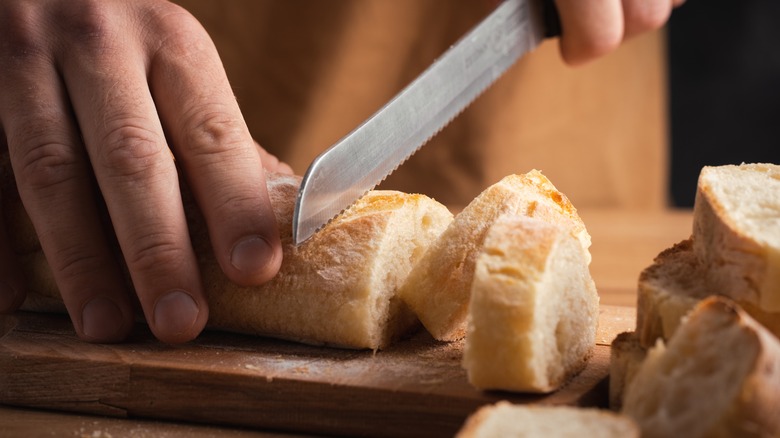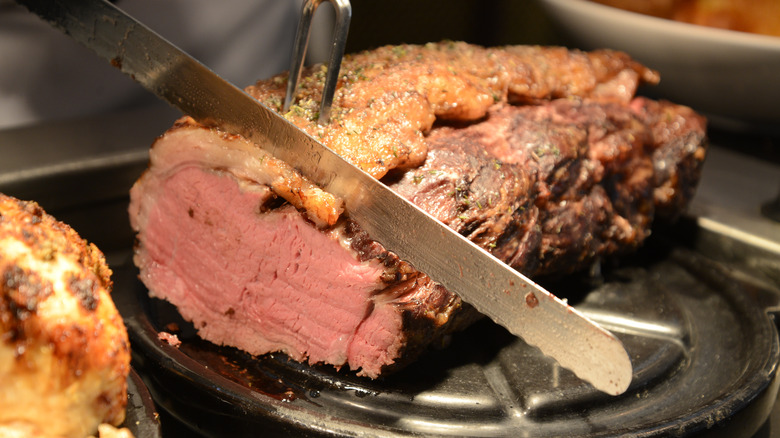The 4 Knives Ina Garten Says Every Cook Needs
You could argue that aside from all the pots, pans, cooking tools, and accouterments, a well-equipped kitchen relies on a proper set of knives. Professional chefs will often speak of the only three knives you need in your kitchen arsenal — known as "the big three" — as being a chef's knife, paring knife, and serrated knife. In a recent Instagram post, Ina Garten disclosed that she includes one more to round out her list to four favorites with the inclusion of a slicing knife. A set of high-quality knives can be expensive, but the Barefoot Contessa says the cost is an investment in quality that will "last a lifetime."
With her examples of how she uses two of these knives, Garten explained that a serrated knife is best used for cutting bread as well as tomatoes. The notched blade edge works best for these soft foods because it slices through them smoothly without tearing. Her demonstration proves how cleanly the knife cuts through a loaf of bread without crumbs going everywhere, along with creating nice, plump tomato slices that don't get smashed as the blade moves through them. Chef's knives on the other hand are best for chopping and dicing. For this example, Garten's method for how to safely chop an onion came with tips such as not pressing down with the knife but instead using the tip to push through in a forward motion.
Serrated and chef's knives are indispensable
In many ways, a chef's knife functions as a multi-purpose go-to knife that can handle most all kitchen tasks. These usually have a blade that's between 8 and 10 inches, with a curved or rounded tip that allows for rocking back and forth. This versatile cutting tool is excellent for chopping vegetables, dicing fruits, and can even be used to slice or butcher meats. Its long, flat edge is also handy for pushing cut ingredients off your cutting board and into a bowl or pan.
While they share some similarities and can be used for a variety of purposes, there is a difference between a chef's knife and a santoku. The Japanese knife is shorter (usually 6 to 7 inches), with a thinner and straighter edge (there is no curve at the end). It's best used for slicing and trimming, especially where detailed work is needed, such as when making beautiful fish slices for sushi or removing the fat off of a piece of steak.
A serrated knife is sometimes just called a bread knife. These also have long blades but with a saw-toothed edge. That jagged line slices neatly through bread's tough outer crust as well as its spongy interior. Along with tomatoes, they're good for fruits with thicker or waxy skin but softer insides (like pineapples and plums), as well as cakes and similar crumbly baked goods. They're even Giada De Laurentiis' favorite tool to easily chop chocolate bars.
Why you need paring and slicing knives
Paring knives are like mini chef's knives with their similar shape — but with a smaller blade that's under 4 inches. They function in much the same way but are better suited for smaller foods or where you need to be more precise. They're perfect for hulling strawberries, coring apples, and slicing little fruits such as blueberries or cranberries. You can use them to mince herbs, slice garlic, or devein shrimp. Paring knives are also just the right size for peeling most fruits and vegetables.
Ina Garten's fourth addition to "the big three" is a slicing knife. Often referred to as a carving knife, the two names actually belong to two different tools with similar but distinct applications. Both have long, narrow blades (8 to 12 inches) designed for slicing meat. However a slicing knife is meant for thin slices of boneless meats, and a carving knife is better at handling thicker bone-in cuts.
A slicing knife's tip is rounded, which allows it to cut very thin slices of meat — such as for making roast beef, turkey, or pastrami sandwiches. The long blade helps with cutting even slices from bigger sized roasts. These will usually have what's called a Granton edge, which are shallow indentations on the blade that prevent the meat from sticking to the metal. What sets a carving knife apart is a pointy tip and a more flexible blade for steering around bones, cartilage, and other tough bits.



